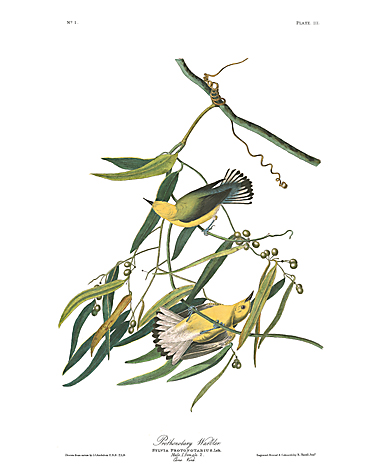|
Havell Name
Prothonotary Warbler Common Name Prothonotary Warbler Havell Plate No. 003 Paper Size 39" x 28" Image Size 15" x 11" Price $ 800 |
||||
|
Ornithological Biography I never saw this pretty bird in any of our eastern districts, and rarely farther up the Ohio than Louisville, in the neighbourhood of which place it rears its young. Louisiana seems in fact better suited to its habits than any other state, on account of its numerous lakes, creeks and lagoons, over-shadowed by large trees, which are favourite places of resort for this species. It is fond of flying over the waters of these creeks and lagoons, and is seldom seen in the interior of the woods. Its flight is rapid, and more steady than is usual in birds of its genus; and as it moves along, the brightness of its colours attracts the eye. On alighting, it moves rapidly along the twigs, partly sidewise, frequently turning about and extending its neck to look under the leaves, from which it picks various kinds of insects. It often perches upon the rank grasses and water plants, in quest of minute molluscous animals which creep upon them, and which, together with small land snails, I have found in its stomach. It does not, perform sorties, or sally forth after flying insects, as many other Warblers are in the habit of doing. It has a few notes for its song, which possess no interest. The males, when chasing each other, keep up a creaking noise, until the little battle is over, when they perch and balance their body with much grace and liveliness. |
|||||
|
|
|||||


| Home | Gallery | Audubon Biography | About Edition | Testimonials | Authorized Dealers | Links | Contact Us |

© Copyright 2007-2025 Zebra Publishing, LLC. | All Rights Reserved Terms of Use
Powered by Fusedog Media Group
